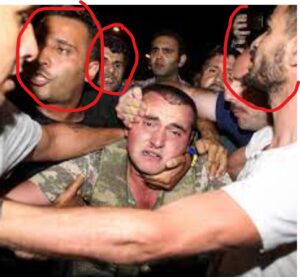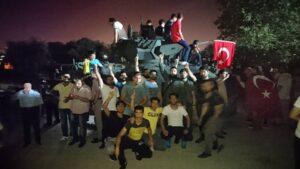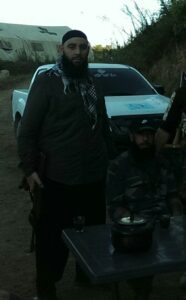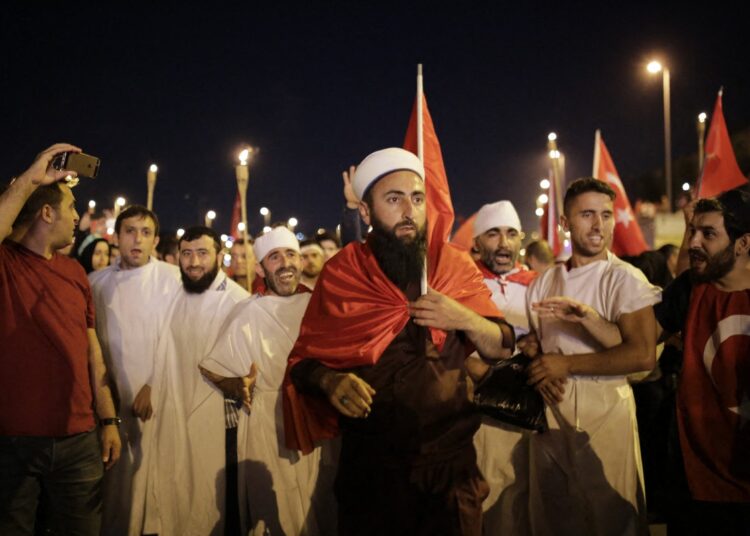Abdullah Bozkurt/Stockholm
The Turkish intelligence agency, MIT (Milli İstihbarat Teşkilatı), transported weapons and fighters from Syria to support a false flag coup attempt in 2016 in order bolster Turkish President Recep Tayyip Erdogan’s rule and facilitate the consolidation of an imperial-style, more authoritarian governance in Turkey.
Numerous testimonies, video footage and photos submitted as evidence in court documents and a confession from a notorious jihadist in Syria all combine to suggest that MIT facilitated the clandestine transportation of unregistered firearms and ammunition from Syria, in addition to jihadist fighters, prior to the events of July 15, 2016. The purpose of this operation was to create a state of chaos in which violence erupted, tragically leading to civilian and military casualties.
In addition to jihadists from Syria, it has been reported that a Turkish paramilitary group, a charity organization suspected of providing logistics support to groups such as al-Qaeda and the Islamic State in Iraq and Syria (ISIS) and a designated Turkish al-Qaeda terrorist organization also played a role in contributing to efforts aimed at escalating the violence during the events of July 15.
The orchestrated chaos on the streets served as a catalyst for President Erdogan to declare a state of emergency, enabling him to carry out widespread purges within Turkey’s key institutions, including the military, police and judiciary, resulting in the dismissal of well over 100,000 government employees. During the ensuing state of emergency, fundamental rights were significantly restricted, and freedoms such as those of assembly and the press were effectively suspended.
Amid these circumstances, President Erdogan expedited a referendum aimed at transforming the parliamentary democracy into a presidential system, removing checks and balances that could restrain his authority and paving the way for a more repressive rule in Turkey.
During his testimony at the Ankara 17th High Criminal Court on February 7, 2019, Lt. Col. İlkay Ateş, a combat helicopter pilot, revealed to the panel of judges that he had been informed by a MIT officer during questioning in 2016 that the agency had brought two truckloads of weapons and fighters from northern Syria into Turkey prior to July 15.
Court transcript that reveals the involvement of Syrian jihadists in the events of July 15, 2016:
The identity of the intelligence officer was not disclosed, but according to Ateş, this operation was explained as part of a larger effort to create a pretext that would justify the mass purge of civil servants under the state of emergency.
The jihadist fighters who were covertly transported to Ankara and Istanbul were initially deployed in the Turkmen region of northern Syria. It’s worth noting that MIT had been extensively involved in training, providing equipment and funding jihadist groups in this area. This support was part of a broader strategy aimed at establishing a Turkish sphere of influence on Syrian territory, with the ultimate objective of overthrowing the Bashar al-Assad regime and replacing it with an Islamist government.
A group consisting of both Syrian nationals and Turks who had traveled to Syria to fight alongside jihadists was brought to Turkey and mobilized on the night of July 15 in Istanbul and Ankara with the intention of inciting violence and chaos. These individuals were strategically deployed in various areas well before tanks in Ankara and Istanbul began to move in response to what military officers said was an imminent terrorist threat. The government later characterized the military mobilization as a coup attempt.
The operation, which entailed the deployment of both foreign and Turkish jihadists from Syria, was authorized personally by President Erdogan. It was coordinated by Hakan Fidan, the then-undersecretary of MIT, and executed by Kemal Eskintan, who served as head of special operations within the agency. Eskintan, known by the nom de guerre “Abu Furkan” in Syria, had long been involved in collaboration with jihadist groups in both Syria and Libya, leveraging them as proxies to further the political objectives of the Erdogan government.

On the night of July 15, while the orchestrated events were unfolding to make a limited military mobilization appear to be a genuine coup attempt, Fidan was present at MIT headquarters, closely monitoring the developments. Seated next to him was Ahmad Moaz Al-Khatib Al-Hasani, who at the time served as president of the National Coalition for Syrian Revolutionary and Opposition Forces. This opposition group received support from Turkey and predominantly comprised Islamist rebel groups. It is alleged that Al-Khatib played a role in assisting MIT in selecting jihadists who were enlisted to participate in this false flag operation in Turkey.
There have been reports suggesting that some of the deaths in Ankara and Istanbul during the events of July 15 included brutal acts, such as murdering an unarmed cadet and later decapitating his body on the Bosporus Bridge, carried out by these jihadists. To obscure the identities of those involved and to cover up these murders, President Erdogan issued a decree granting full immunity from criminal prosecution for anyone who had taken part in the incidents of July 15 and 16.
It has also been reported that some of the victims had ammunition extracted from their bodies that was not consistent with Turkish military ammunition and had not been stored in official army stockpiles, raising questions about the circumstances surrounding their deaths.

Furthermore, it has been reported that prosecutors did not order ballistic examinations of the guns allegedly used in these murders. Hand swabs from suspects were not taken, and in certain cases, autopsies were not performed by the authorities. Alarmingly, some medical reports that were meant to examine bullet holes and wounds sustained by the victims mysteriously disappeared.
These actions, or the lack thereof, strongly suggest that the Erdogan government deliberately obstructed the investigation with the intention of preventing the full disclosure of what truly transpired during the events of July 15 and obscuring the identities of the real perpetrators of the murders.
The efforts to obstruct the investigation notwithstanding, pieces of information from witness accounts have consistently supported the claim that the guns brought into Turkey by MIT from Syria were distributed well in advance of any military action on July 15.
Testimony from individuals such as a former police chief who was on duty at the time have revealed that police officers distributed firearms to civilians in a parking lot near the Etlik Forum Outlet mall in Ankara. Another police officer who was also on assignment that night attested to witnessing the distribution of two truckloads of firearms to civilians in the Turkish capital. These accounts align with the assertion that the distribution of weapons was orchestrated ahead of the events of July 15.
Emrah Çelik, a member of the ruling Justice and Development Party (AKP) youth branch who had joined al-Qaeda groups in Syria, openly confessed in an interview that he and his jihadist associates were mobilized in 2016. He said, “On the night of July 15, we and our entire organization joined the armed campaign,” thereby acknowledging the involvement of al-Qaeda-affiliated groups from Syria in entering Turkey to support the Erdogan government during the events of that night.

Çelik was previously identified by Nordic Monitor as al-Qaeda militant. He was seen posing in both a video and still shots while holding a severed head in his hand. The recording shows him saying that the victory belongs to Islamist jihadists and that whoever takes on Islam’s soldiers would share the same fate as the owner of the severed head.
Multiple witness accounts detailing the chaotic events surrounding General Staff headquarters on July 15 indicate that some of the civilians who stormed the headquarters in Ankara were armed with guns and knives. These witness testimonies shed light on the orchestrated nature of the chaos that unfolded that night.
The story of Muhammed Emin Kekat, a 24-year-old Syrian who was hailed as a hero in the pro-government media for driving an abandoned tank in the Kızılay neighborhood of downtown Ankara during the events of July 15 has raised more questions and suspicions. According to the police, he was seemingly the only individual present who knew how to operate a tank, which led many to believe that he may have been part of a group strategically positioned well in advance of the deployment of army tanks on terror alert in and around military installations.

In addition to recruiting jihadists from Syria, it has been reported that Turkish intelligence also enlisted the support of radical and jihadist groups already present in Turkey. It appears that there was a broader network of actors involved in the events of July 15, including both foreign and domestic elements, with the aim of making the alleged false flag operation appear more credible to the public.
One of these domestic groups from which MIT sought assistance was Turkish al-Qaeda group the Islamic Great East Raiders Front (İslami Büyük Doğu Akıncıları Cephesi, IBDA-C), which is designated as a terrorist organization due to its involvement in violent attacks and bombings in Turkey. The fact that IBDA-C openly claimed responsibility for their militants participating in the events of July 15 under the pretext of opposing alleged putschists was a significant revelation.
Multiple photos shared by the group that show its militants on the streets on July 15 provide further evidence of their involvement in these events.
IBDA-C, which faced a significant crackdown in the 1990s and early 2000s resulting in the imprisonment of many of its members, saw a resurgence under President Erdogan’s leadership. Erdogan secured the release of several of its members from prison, including the infamous late leader Salih İzzet Erdiş, who was also known by his adopted name, Salih Mirzabeyoğlu, and who was serving a life sentence.
IBDA-C played a role in the recruitment of Turkish jihadists who eventually joined the ranks of al-Qaeda and ISIS to fight in Syria. Additionally, the group’s militants have been alleged to have taken to the streets to send political messages when it was deemed convenient by the Erdogan government. IBDA-C has reportedly organized protests in front of foreign embassies and consulates as part of tasks assigned to them by Turkish intelligence.

Up until 2014, IBDA-C had been closely monitored by the Turkish police, and there were 17 planned intelligence sweeps against the group, leading to the criminal prosecution of its militants. By August 2009 the police had detained a significant number of IBDA-C militants, 1,186 in all. During these operations, law enforcement seized 146 guns of various calibers, 80 hand grenades and explosives components. Furthermore, the police claimed to have solved a total of 219 terrorist acts committed by IBDA-C militants and prevented 28 terrorist plots that were in the planning stages.
The police chiefs and prosecutors who had played key roles in cracking down on IBDA-C were subsequently purged from their positions between 2014 and 2017. Following their departure, the new officials who took over appear to adhere to the government’s stance on IBDA-C and have refrained from actively investigating IBDA-C militants.

Video footage circulating on social media around the time of July 15 showed a Turkish man named Ibrahim wearing a black beret, sporting an al-Qaeda style beard and black sunglasses and dressed in camouflage walking around the perimeter of a military base. He appears to have had military training and is holding a pistol amid the sounds of gunfire and sirens. In the video he says he and his friends came at the request of a Turkish police officer, which suggests that their deployment was planned long before.
This video footage appears to support the notion that the deployment of individuals with extremist affiliations was premeditated and planned in advance of the events that transpired that night.
Ibrahim’s social media profile revealed that he had been in Syria fighting for a Turkish intelligence-backed jihadist group known as the Sultan Abdulhamid Brigade. This affiliation, along with his alignment with IBDA-C affiliate the Müslüman Anadolu Gençliği (Muslim Anatolian Youth), adds further context to his presence and activities on the night of July 15.
Turkish jihdist’s video:
Another group that was mobilized by the Erdogan government was the Foundation for Human Rights and Freedoms and Humanitarian Relief (İnsan Hak ve Hürriyetleri ve İnsani Yardım Vakfı, or IHH), a Turkish jihadist charity that helped both al-Qaeda and ISIS in Libya and Syria. The IHH has been known to coordinate its actions with Turkish intelligence agency MIT.
The revelation by Fatih Tezcan, a prominent propagandist associated with President Erdogan, that armed IHH groups were present in the streets of Istanbul on July 15, led by its chairman Bülent Yıldırım and his deputies, was significant. He claimed it was this group that liberated the Istanbul police station on Vatan Street from the putschists, which was not the case since the building was never seized by the military. Yıldırım himself admitted to mobilizing people on that night and claimed the IHH helped prevent the putschists from succeeding in their attempt.
The last group that was enlisted by the Erdogan government to execute the false flag was paramilitary group SADAT, short for Uluslararası Savunma Danışmanlık İnşaat Sanayi ve Ticaret Anonim Şirketi, a for-profit company that was set up by retired general Adnan Tanrıverdi and his associates in 2012. Gen. Tanrıverdi played a significant role in the post-July 15 purge of pro-NATO officers in the military and subsequently became a chief military advisor to President Erdogan.

The assertion by Nevzat Tarhan, one of the key figures associated with the SADAT group, that around 1,000 former army personnel with expertise in military hardware were present on the streets during the events of July 15 as part of SADAT’s operation was another significant claim. This would suggest a substantial and coordinated effort by SADAT to mobilize individuals with a military background for specific purposes on that night. It adds to the growing body of information indicating the involvement of various groups and individuals, all coordinated by Turkish intelligence, in the events of July 15.
The events of the July 15 false flag operation certainly had significant implications for the political landscape in Turkey. They served as a turning point for President Erdogan, allowing him to consolidate power, eliminate checks on his rule and fill government institutions with individuals loyal to his agenda after the mass purge of well over 100,000 civil servants.












